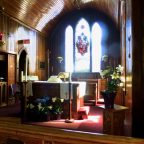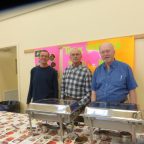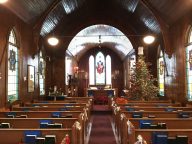May 28, 2017 Sermon Easter 7
Up, Down & Out
Last Thursday, the church celebrated one of the minor festivals of the Church Year, the Ascension of our Lord.
It’s an odd little story, and we only find it in Luke … and he tells it twice—once at the end of his gospel; and then he repeats it at the beginning of Acts. The book of Acts is part 2 of Luke’s story. It’s a sequel … like The Empire Strikes Back or The Godfather Part 2. Luke’s purpose in writing this sequel is to show that Jesus’ death and resurrection is not the end of the story. The story of God’s dream continues in the life of the church.
Luke writes this story about Jesus ascending to heaven, some 40 days after the resurrection. The point of the story is that Jesus is gone. He is no longer with us on earth—so now what?
This is a transition story. It’s an interlude.
Up till now, the story has been all about Jesus living on earth, teaching his disciples, showing the world how we might all experience God’s love in our lives.
But then the state executed him. Just like that, he was gone. But that wasn’t the end of the story. The world was surprised by God’s gift of new life. Jesus is risen! He’s alive! Alleluia!
But there’s something different. It’s not the same. Jesus tells his disciples that he must return to the Father.
So what happens now? Now what?
Through this story, Luke lets the church know that God’s love continues to pervade their lives. Even though Jesus is gone, God’s love for the world hasn’t ended. Now it’s up to the church to live God’s love out the same way Jesus did. Now it’s up to the church to live a life filled with God. The story of God’s dream which began in the life of Jesus continues now in the life of the church.
With this story of Jesus ascending, Luke wants us to know that while Jesus’ body may be gone, his spirit remains with us.
The disciples, who are still uncertain about it all, ask a final question: “Is this the time? Now will everything we had hoped for come to pass?” Jesus responds that the time is held in God’s hand. Our work is to be witnesses, to tell the story of God’s dream, to participate in God’s dream of a world which is whole for all creatures.
“You will be empowered…” says Jesus. And then he is lifted from their sight. The disciples stand there watching, and two men in white appear and ask, “What are you doing here, looking into the sky?” It’s as if they’re telling us, “Don’t stand around speculating. Get out there and tell others about the love of God.”
It reminds me sometimes of the old Star Trek episodes. “Beam me up, Scotty.” Captain Kirk, Mr. Spock and the away team have finished their work on a planet; when it was done, they would be teleported back to the Enterprise. “Beam me up, Scotty”.
Part of what’s going on here is that in Luke’s time, people saw the earth differently than we do. They lived in a three–storey universe.
We live in the middle storey, the earth. As everyone can see, it’s a flat disc. When I lived in Regina, you could almost believe that the world was flat like that. All you saw was flat land, bounded at the horizon by hills and mountains.
Underneath us, on the ground floor, the earth is held up by pillars arising from Sheol, the underworld. And up there, on the third floor, beyond the sky … well that’s heaven. That’s where God lives. So of course, Jesus goes up. He ascends.
That’s the worldview in which the Bible was written. We know now of course that the world is a beautiful and fragile ball spinning in space amidst millions of other stars and galaxies and universes.
But even though we know differently, our language still reflects that ancient cosmology. If I tell you to look to heaven, your eyes automatically go up. We still think of good as being up … and bad being down. It’s natural for us to say things like “I’m down in the dumps” or “I feel really good today. I’m up for it.”
This story is not meant literally. It’s an image, a metaphor for something profound that happens in the life of the church. This story is about moving up … and down … and out.
We’ve already talked about up. Jesus ascends. He is not held in the grave; he returns to God. Our faith trusts deeply that death never has the last word. Our faith is about life … and not just life in the future, but abundant life in the present.
Up … means that death is not the last word. God’s love and power and grace and life are the last word, and God’s love works through us as we live in this world.
Second, down. Jesus promises that God’s holy Spirit will come down. Holy Spirit is the empowering presence of God in our midst. Holy Spirit comes upon us … into us … among us … within us … through us. That’s what Pentecost is all about. We’ll celebrate that next Sunday.
But the point here is that holy Spirit is here now—filling us, empowering us, infusing us with life. God’s life revives our lives, making us more than we could ever be on our own. God’s life courses through our veins so that we can share the good news of God’s powerful love and loving power with the world.
Third, out. The church is sent out. We don’t get holy Spirit so we can sit here and feel good about ourselves and each other. Holy Spirit drives us out into the world to tell others about this good news we’ve experienced, to share with others the good news of life.
That begins in worship. We come together as a community of God’s people to focus on the good news of life. In worship, we learn that God’s holy Spirit fills us. In worship, we are renewed in our commission to tell good news. In worship, we receive strength and hope to live as God’s people in the world. In worship, we hear again the wonderful news that we are precious and valuable people, beloved and treasured by God.
This is not the only place where we experience God’s grace in our lives. We can get that in so many different ways … in nature, through friends and family, in the arts, in quietness and in celebration.
But worship is the time where we focus on God intentionally. Worship is the time we gather with brothers and sisters to be renewed. Worship is when we wait together to receive God’s power and life. Worship shapes our lives to be more responsive to God.
We wait together … as the early church waited … to receive power, to be filled with holy spirit, to be renewed as lovers of creation with God.
Beam me up, Scotty. That’s what they said in Star Trek when their work was done. Jesus’ work is done. Now we continue the work of God in the world … not on our own, but accompanied with the presence and holy spirit of this loving, giving, life–giving God.
Thanks be to God.
Rev. Dr. Yme Woensdregt
May 28, 2017 (7th Sunday of Easter)
Acts 1: 6–14
John 17: 1–11







